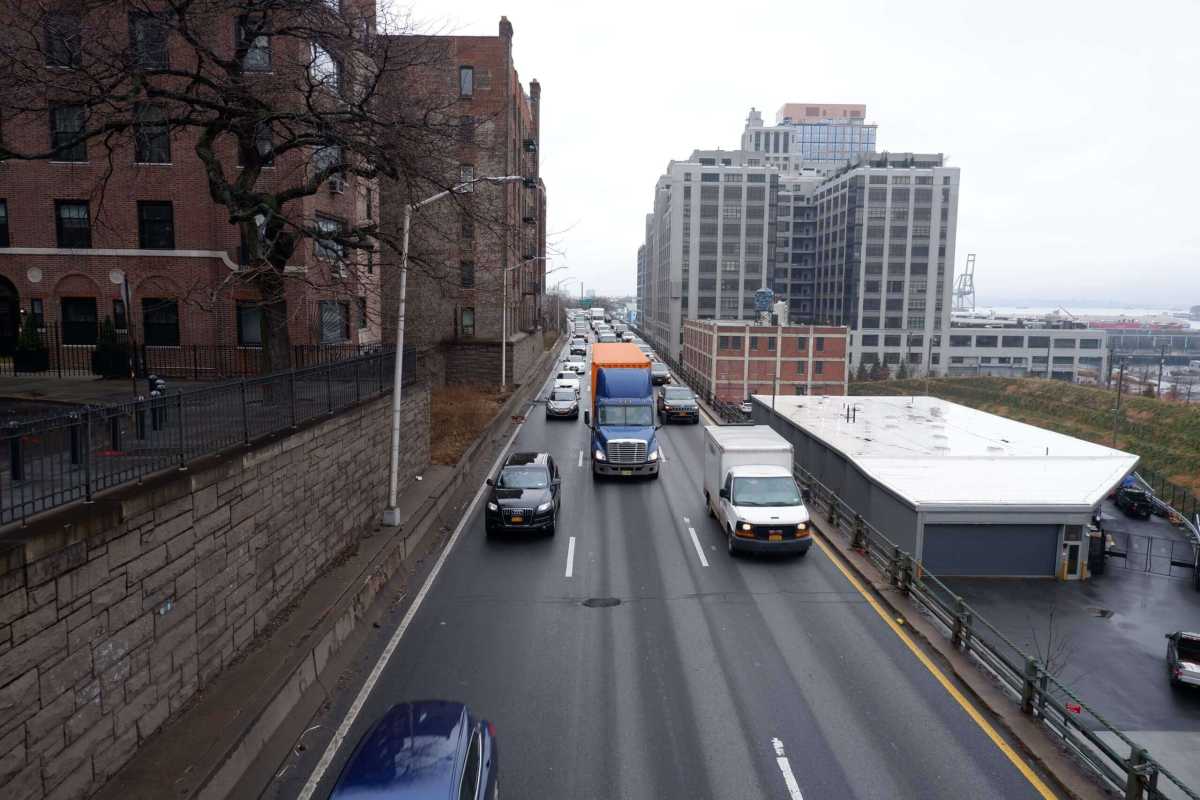Eighteen of Brooklyn’s elected officials slammed the state’s Department of Transportation on Thursday after it confirmed there are no plans to refurbish the state-owned portions of the Brooklyn-Queens Expressway.
“New York State DOT’s refusal to commit to participating in NYC DOT’s visioning process for their portions of the BQE is completely unacceptable and irresponsible,” the pols said in a joint statement. “This historic opportunity to rebuild the BQE extends beyond the Triple Cantilever and our communities deserve a forward thinking vision that redesigns the entire BQE and addresses the significant environmental justice impacts of the thruway.”
The missive, signed by everyone from U.S. Rep. Nydia Velázquez to Brooklyn Borough President Antonio Reynoso and a number of local councilmembers, came a day after Streetsblog reported that, despite repeated requests for assistance from elected officials, the state DOT’s involvement in the “reimagining” of the BQE will go no further than helping the city with its redesign of the 1.4-mile city-owned portion of the highway.
The city and state split ownership of the BQE
New York State controls the majority of the 12-mile thoroughfare, which stretches from the Kosciuszko Bridge to the Verrazzano-Narrows Bridge, while the city owns the 1.4 miles between Sands Street and Atlantic Avenue, including the infamous — and crumbling – triple cantilever alonng the Brooklyn Heights waterfront. Last year, Mayor Eric Adams announced a wide-ranging public engagement plan to brainstorm ideas to improve the entire corridor, not just the oft-discussed city-owned BQE Central.
“As we have said from day one of this effort, the Adams administration is committed to an equity-focused, corridor-wide approach to the BQE,” said DOT spokesperson Vin Barone. “We are investing $500,000 in more than a dozen community-based organizations to help us reconnect communities along the entire corridor that have been separated by the highway, and we have been in touch with our state colleagues and hope to work closely with them to advance these critical projects.”

But, as public meetings and planning progressed, some pols said the state was noticeably absent — and the city can’t do any work on the state-owned portions of the roadway without state buy-in. On Feb. 6, at a hearing in Albany, Assemblymember Emily Gallagher raised those concerns with NYS DOT commissioner Marie Therese Dominguez.
“There has been a strong perception in my community that the state is not at the table in the same way the city is in the revisioning of what the BQE can look like,” Gallagher said. “My communities have been divided by the BQE, we’ve suffered enormous environmental impacts, we’ve also suffered environmental justice impacts with childhood asthma and other situations caused by the presense of this major highway.”
The northern Brooklyn communities Gallagher represents want to see a “totally different vision,” she said, and she wanted to know what the DOT had in mind.
Dominguez said the state DOT had been in communication with the city as it develops the environmental documentation related to reconstruction of the triple cantilever. Over the last decade, she added, the state has invested more than $1 million in the BQE.
“What we’re looking at right now is future needs within the city study area,” she said. “We anticipate our investment is going to be somewhere around an additional $300 million over the next five years, and we’re going to really be looking at some of those structural deficiencies.”

The answer — indicating that the state was not looking further afield, at the other areas of the highway — didn’t satisfy Gallagher.
“My community does not want the BQE to be repaired, we want it to be revisioned and totally changed,” the Assemblymember said. “We’ve tried to have multiple meetings with state DOT and they haven’t worked out over the last ten years, and I just know we need to have a stronger dialogue about what the BQE repairs and changes look like, because we are not part of the city BQE portion. We are only state, and we do not feel like we are being heard or seen.”
‘We do not have decades more to wait’
The structurally-unsound city-owned triple cantilever has been at the center of a number of revisioning plans over the years, largely due to dire warnings from engineers that the structure is becoming more less stable and more dangerous by the year. Per Adams’ revisioning plan, construction should begin by 2024. But the entire Robert Moses-constructed roadway is an eyesore at best and a public health hazard at worst, critics say, and it cuts communities off from themselves all the way down through Red Hook, Sunset Park, and Bay Ridge.
“The ‘technical assistance’ NYS DOT has said they are providing to the NYC DOT is not enough,” the politicians said. “We need the state to truly come to the table, and engage directly with us on this issue. The neighborhoods from Bay Ridge to Greenpoint have suffered from the social, health, and economic impacts of the BQE for decades: with the climate crisis upon us, we do not have decades more to wait. We ask that the NYS DOT remember the daily harms caused by the BQE in its current state — not just the crumbling cantilever section — and join us at the table in search of a solution.”

























